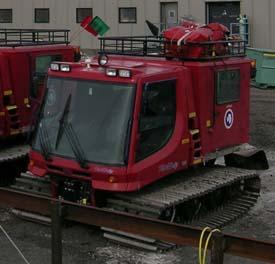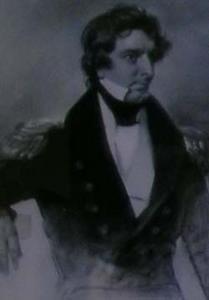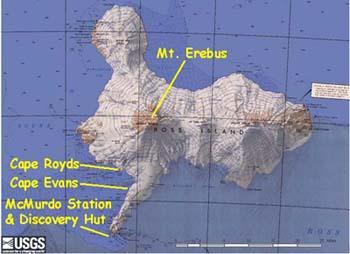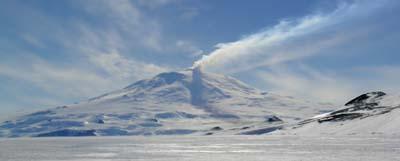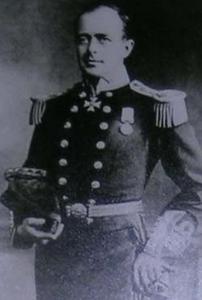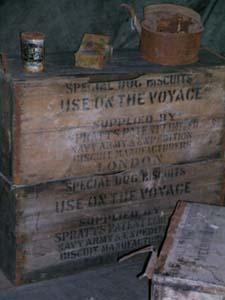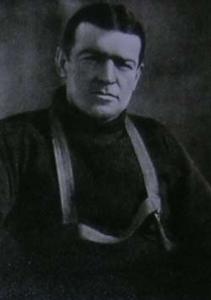
|
29 November, 2003Heroic Age of Exploration – Scott’s Discovery Expedition As snow fell on McMurdo today (Figure 1), we celebrated Thanksgiving (it was moved to Saturday to give the staff a long weekend) and gorged ourselves on turkey, stuffing, mashed potatoes, pumpkin and apple pie, and other traditional trimmings. As I pushed back from the table, feeling faintly sick from the volume of food I had just inhaled, I couldn’t help but reflect on our week spent stranded in McMurdo. We’ve spent part of our time exploring the historic huts sprinkled along Hut Point Peninsula. I have always enjoyed hearing stories from the Heroic Age of Exploration in Antarctica, but until now they have been just that – good stories. In my mind the phrase “Heroic Age” conjures images of brave men triumphantly returning home from their adventures to the applause of an admiring public which ravenously devoured tales of their daring exploits. But for Antarctica explorers, this was rarely the case – some never made it home and others returned to a world embroiled in war. On a personal level, investigating the isolated huts that dot the icebound beaches, experiencing a summer snowstorm, and imagining what it would be like to shed my warm bib overalls and down parka for the wet, threadbare wool garb of the early explorers brings these “stories” into a chilly new light. Exploration of the South Polar region dates back to 1772 when Captain James Cook circumnavigated the Southern Ocean for Great Britain, reaching 71º10' South latitude, but never spotting the Antarctic continent. It wasn’t until 1820-1821 that Captain Nathaniel B. Palmer sighted a piece of Antarctica, now called Palmer Peninsula, below South America. On the other side of Antarctica, James Clark Ross (Figure 2) went in search of the magnetic South Pole in 1839-1843 and sailed into the McMurdo Sound area in the Ross Sea (Figure 3). Ross Island (Figure 4), which bears his name contains two volcanoes, named after his ships the Erebus and the Terror. Ross reported seeing a gas plume coming from Erebus (Figure 5) and noted what appeared to be lava flows issuing from the lower crater. It is this continuously active volcano that brings our team to Antarctica today. The “Heroic Age of Exploration” which most people are familiar with actually commenced in 1895 with the meeting of the Sixth International Geographical Congress in London. The Congress resolved that “exploration of the Antarctic Regions is the greatest piece of geographical exploration still to be undertaken” and declared that “scientific societies throughout the world should urge in whatever way seems to them most effective, that [scientific] work should be undertaken before the close of the century" (http://www.coolantarctica.com/Antarctica%20fact%20file/History/The_heroic_age_of_Antarctic_exploration.htm). In short this doctrine stated that Antarctica was the last continent where a wealth of discoveries were waiting to be made and scientific investigation should be the chief endeavor of all exploratory teams. Captain Robert Falcon Scott (Figure 6) of Great Britain answered the Congress’s call in 1901-1904, sailing into McMurdo Sound. He established his base camp on “Hut Point Peninsula” on Ross Island. A prefabricated shelter called “Discovery Hut” was erected at Hut Point (Figure 7). The hut proved to be too large to effectively heat, so his men stored provisions in the hut (Figure 8), but maintained their sleeping quarters aboard ship. An array of items ranging from “Digestive Biscuits” (Figure 9) and “Special Dog Biscuits” (Figure 10) to wool pants (Figure 11) and racks of mutton (Figure 12) are still present today and accessible for close inspection. From this location, a core team of Scott, Ernest Shackleton and Edward Wilson sledged toward the South Pole conducting scientific observations along the way. Other members of the 29 man Discovery team were assigned to lay depots (food caches) that would allow the polar team to travel light, hopping from food cache to food cache on their return journey. Unfortunately the polar team fell short of its goal, failing to reach the South geographic pole due to malnutrition, scurvy and snow blindness. They were gone from Discovery Hut for 93 days, traveled 960 miles, and fell 480 miles short of the pole. On the return, all three men were afflicted by scurvy (a debilitating condition caused by a deficiency of vitamin C), but Shackleton was parcticularly weakened and needed to be pulled on a sledge for a distance. This prompted Scott to send Shackleton home early on the supply ship the Morning, labeling him “unfit for polar service,” an assessment that drove a rift between the two men and led to Shackleton launching his own polar attempt three years later. Despite its failure, Scott’s British National Antarctic Expedition (or Discovery expedition as it is commonly known) was the first serious attempt to reach the South geographic pole, making it 300 miles farther than any other, and is credited with the first detailed geographic and aerial surveys of Antarctica. Following in Scott’s footsteps were a wide range of expeditions including two polar expeditions by Shackleton (Figure 13) and Roald Amundsen (Figure 14) of Norway, a second bid for the pole by Scott, and Shackleton’s famed Trans-Antarctic expedition. Several other expeditions later used the Discovery Hut as a provision depot, adding to the eclectic inventory that remains in the hut today. We slogged back across the bay to a hot dinner and our warm beds thinking of the men who spent another winter here at Hut Point, collecting scientific and geographic information, despite their failure to claim the pole. As our own Antarctic expedition remains snowbound, I will save the stories of Amundsen and Scott for another day.
Contact the TEA in the field at . If you cannot connect through your browser, copy the TEA's e-mail address in the "To:" line of your favorite e-mail package. |




